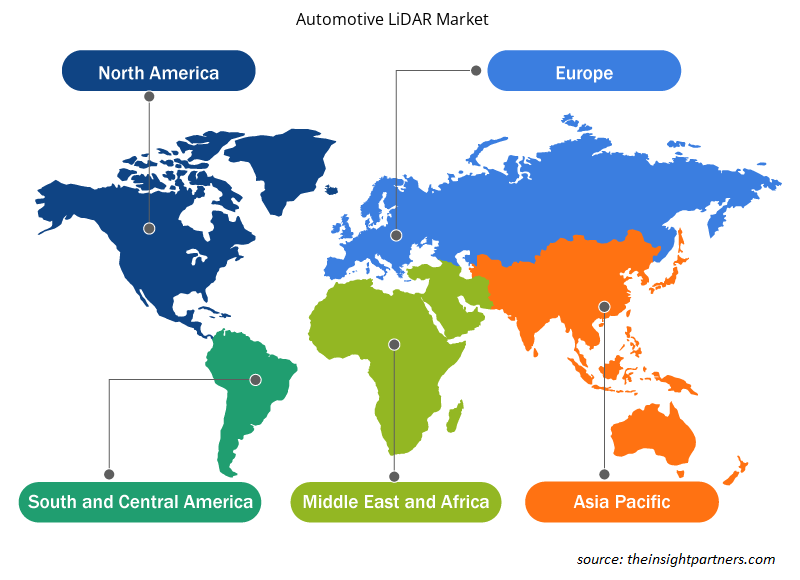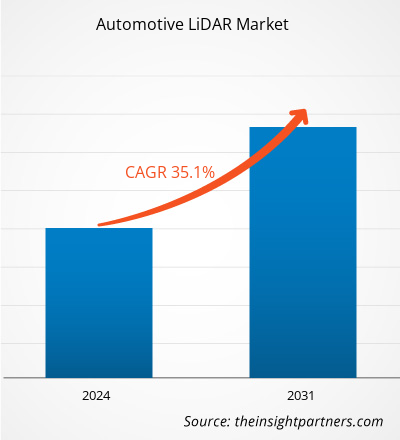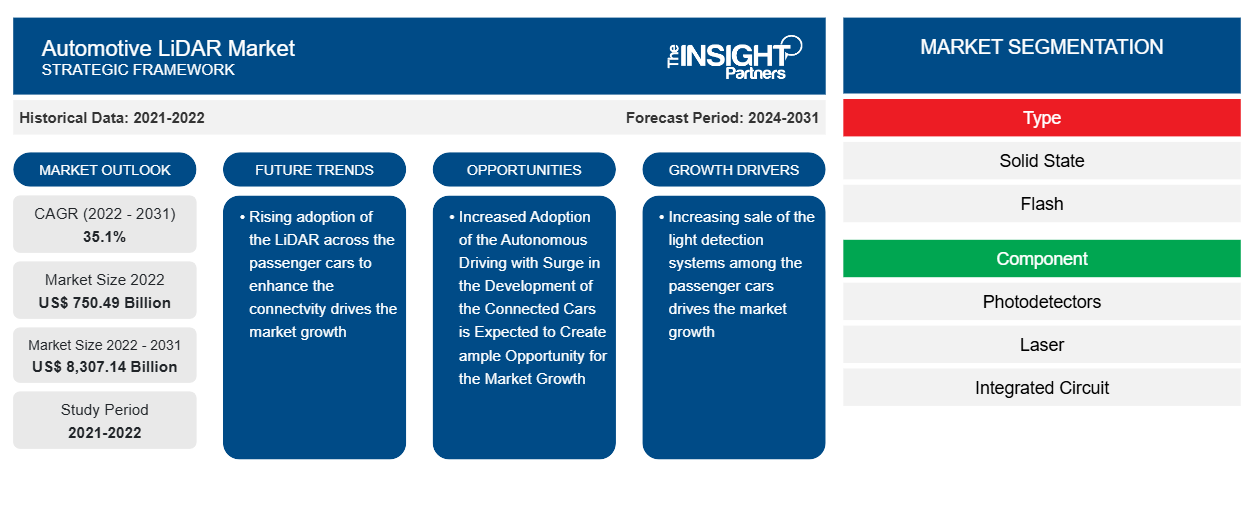Si prevede che la dimensione del mercato LiDAR per l'automotive raggiungerà gli 8.307,14 miliardi di dollari entro il 2031, rispetto ai 750,49 miliardi di dollari del 2022. Si prevede che il mercato registrerà un CAGR del 35,1% nel 2022-2031. Il mercato LiDAR per l'automotive è guidato dalla rapida adozione di auto a guida autonoma insieme a un'impennata nella vendita di auto connesse. Si prevede che il mercato della guida autonoma creerà entrate comprese tra 300 e 400 miliardi di dollari entro il 2035. La crescente domanda di autovetture autonome nei paesi sviluppati, tra cui Stati Uniti e Canada, guida la crescita del mercato LiDAR per l'automotive. Inoltre, la crescente domanda di auto di lusso in tutto il mondo è un importante fattore trainante per la crescita del mercato LiDAR per l'automotive durante il periodo di previsione.
Analisi del mercato LiDAR per l'automotive
Il mercato LiDAR automobilistico è guidato dall'aumento delle vendite di veicoli di lusso, insieme alla maggiore adozione della tecnologia ADAS nei veicoli che sta guidando la crescita del mercato LiDAR automobilistico durante il periodo di previsione. Si prevede che l'aumento degli sviluppi dei veicoli autonomi, insieme a un'impennata delle vendite di veicoli elettrici costruiti con tecnologia LiDAR, creerà significative opportunità di crescita del mercato LiDAR automobilistico. Le aziende nel mercato LiDAR automobilistico si concentrano sullo sviluppo di nuovi prodotti e sul lancio di nuovi sensori basati su tecnologie autonome . Ad esempio, a gennaio 2022, Innoviz Technologies Ltd. ha lanciato il sensore Innoviz360 di nuova generazione nella sua linea di prodotti. Innoviz360 ha generato ricavi nel 2023.
Panoramica del mercato LiDAR per l'automotive
Si prevede che l'adozione crescente di veicoli autonomi supporterà la crescita del mercato LiDAR automobilistico. Le tecnologie automobilistiche e dei veicoli connessi utilizzano LiDAR per ottimizzare il loro utilizzo. I principali OEM, come Audi AG, BMW AG, Ford Motors, Mercedes-Benz, Nissan Corporation, Tesla Inc. e AB Volvo, offrono assistenza alla guida autonoma di livello 2 a livello globale. Questi includono sistemi automobilistici che offrono assistenza all'accelerazione, allo sterzo e alla frenata durante la guida in autostrada. La penetrazione delle auto connesse con l'aumento dell'adozione di veicoli automatizzati nel mondo reale nelle nazioni sviluppate, tra cui Regno Unito, Stati Uniti e Germania, guida la crescita del mercato LiDAR automobilistico durante il periodo di previsione. I servizi in-car connessi offrono diversi servizi, come mappe connesse, sistemi GPS e assistenza allo streaming musicale basata su app. Si prevede che tutti questi fattori creeranno ampie opportunità per la crescita del mercato LiDAR automobilistico durante il periodo di previsione.
Personalizza questo report in base alle tue esigenze
Riceverai la personalizzazione gratuita di qualsiasi report, comprese parti di questo report, o analisi a livello nazionale, pacchetto dati Excel, oltre a usufruire di grandi offerte e sconti per start-up e università
-
Scopri le principali tendenze di mercato in questo rapporto.Questo campione GRATUITO includerà analisi di dati che spaziano dalle tendenze di mercato alle stime e alle previsioni.
Driver e opportunità del mercato LiDAR per l'automotiveLiDAR Market Drivers and Opportunities
Si prevede che l'aumento delle vendite di sistemi di rilevamento della luce tra le autovetture sarà il principale motore del mercato LiDAR per l'automotiveLiDAR Market
La crescente penetrazione dei sistemi di rilevamento della luce e l'impennata nella penetrazione delle soluzioni LiDAR avanzate nelle autovetture rappresentano un importante fattore trainante per la crescita del mercato LiDAR automobilistico durante il periodo di previsione. Inoltre, la domanda in rapida crescita di auto autonome e connesse, insieme all'aumento delle partnership di OEM automobilistici e altre organizzazioni, sta anche fornendo una significativa crescita del mercato LiDAR automobilistico. L'auto autonoma offre praticità ai passeggeri e migliora il livello di sicurezza dei viaggiatori. Questi veicoli autonomi offrono opportunità redditizie per diverse aziende automobilistiche per accedere a un'ampia gamma di sensori e sistemi LiDAR autonomi per generare ricavi.LiDAR solutions in passenger cars is a major driving factor for the automotive LiDAR market growth during the forecast period. Furthermore, the rapidly increasing demand for autonomous and connected cars, along with the increase in partnerships of automotive OEMs and other organizations, is also providing significant automotive LiDAR market growth. The autonomous car provides convenience for the passengers and improves the safety level of the travelers. These autonomous vehicles offer lucrative opportunities for several automotive firms to access a wide range of sensors and autonomous LiDAR systems to generate revenues.
L'adozione di tecnologie LiDAR per l'automotive aiuta nel rilevamento della luce e fornisce tecnologia di assistenza alla navigazione per i proprietari di veicoli. Un altro utilizzo del LiDAR per l'automotive è in ADAS e LiDAR nei robotaxi e nei servizi di ride-sharing. La crescente domanda di servizi di autonoleggio on-demand, servizi navetta on-demand e mobilità come servizi sono i principali fattori trainanti per il mercato LiDAR per l'automotive durante il periodo di previsione. Pertanto, gli OEM per l'automotive stanno investendo una notevole quantità di denaro nei sensori LiDAR per lanciare veicoli autonomi di prossima generazione.LiDAR technologies helps in light detection and providing navigation assistance technology for vehicle owners. Another use of automotive LiDAR is in ADAS and LiDAR across robotaxis and ride-sharing services. Increased demand for on-demand car rental services, on-demand shuttle services, and mobility as services are the major driving factors for the automotive LiDAR market during the forecast period. Therefore, OEMs are investing a considerable amount in LiDAR sensors to launch next-generation autonomous vehicles.
Si prevede che la crescente adozione della guida autonoma, insieme all'impennata nello sviluppo di auto connesse, creerà ampie opportunità di crescita del mercato.
Con l'aumento dello sviluppo economico a livello globale, c'è bisogno di tecnologie avanzate per soddisfare l'attuale standard di vita. L'adozione e il lancio della guida autonoma e l'impennata della crescita delle auto connesse guidano la crescita del mercato globale dei LiDAR per l'automotive durante il periodo di previsione. Ad esempio, a luglio 2023, il Gruppo Volkswagen ha pianificato di lanciare veicoli a guida autonoma per l'adozione di servizi di ride-hailing, ride-sharing e consegna di merci negli Stati Uniti entro il 2026. Si prevede che tale crescita della guida autonoma da parte dei principali OEM creerà ampie opportunità di crescita del mercato.
Analisi della segmentazione del rapporto di mercato LiDAR per l'automotive
I segmenti chiave che hanno contribuito alla derivazione dell'analisi del mercato LiDAR per il settore automobilistico sono tipologia, componente e applicazione.
- In base al tipo, il mercato globale dei LiDAR per l'automotive è diviso in stato solido e flash. Tra questi, lo stato solido ha la quota maggiore nel 2023.LiDAR market is divided into solid state and flash. Among these, the solid-state has the largest share in 2023.
- In base ai componenti, il mercato si divide in fotodetectori, laser, circuiti integrati, elementi ottici e altri.
- A seconda dell'applicazione, il mercato è suddiviso in navette autonome, robotaxi e autovetture. Tra queste, le autovetture hanno la quota maggiore nel 2023, a causa della crescente adozione di tecnologie avanzate da parte di OEM, fornitori e provider di tecnologia leader in tutto il mondo.
Analisi della quota di mercato dei LiDAR per l'automotive per area geografica
L'ambito geografico del rapporto sul mercato Automotive LiDAR è suddiviso principalmente in cinque regioni: Nord America, Europa, Asia Pacifico, Medio Oriente e Africa e Sud America.
Si prevede che la regione Asia-Pacifico avrà la quota maggiore nel 2023 per il mercato LiDAR automobilistico durante il periodo di previsione. La crescita di questa regione è dovuta principalmente alla rapida urbanizzazione, all'aumento delle vendite di automobili e a un'impennata nell'adozione di tecnologie avanzate da parte dei principali OEM. Paesi emergenti come India, Cina, Corea del Sud e Giappone stanno crescendo a un ritmo rapido grazie alla presenza di diversi OEM automobilistici leader. Gli OEM automobilistici nella regione Asia-Pacifico includono Hyundai Corporation, Kia Motors, Nissan Corporation, Honda Corporation e Toyota Corporation. Questi attori leader stanno sviluppando auto a guida autonoma automatizzate per soddisfare l'attuale domanda di urbanizzazione.
Approfondimenti regionali sul mercato LiDAR per l'automotive
Le tendenze regionali e i fattori che influenzano il mercato Automotive LiDAR durante il periodo di previsione sono stati ampiamente spiegati dagli analisti di Insight Partners. Questa sezione discute anche i segmenti e la geografia del mercato Automotive LiDAR in Nord America, Europa, Asia Pacifico, Medio Oriente e Africa e Sud e Centro America.

- Ottieni i dati specifici regionali per il mercato Automotive LiDAR
Ambito del rapporto sul mercato LiDAR per l'automotive
| Attributo del report | Dettagli |
|---|---|
| Dimensioni del mercato nel 2022 | 750,49 miliardi di dollari USA |
| Dimensioni del mercato entro il 2031 | 8.307,14 miliardi di dollari USA |
| CAGR globale (2022-2031) | 35,1% |
| Dati storici | 2021-2022 |
| Periodo di previsione | 2024-2031 |
| Segmenti coperti |
Per tipo
|
| Regioni e Paesi coperti |
America del Nord
|
| Leader di mercato e profili aziendali chiave |
|
Densità degli attori del mercato Automotive LiDAR: comprendere il suo impatto sulle dinamiche aziendali
Il mercato Automotive LiDAR Market sta crescendo rapidamente, spinto dalla crescente domanda degli utenti finali dovuta a fattori quali l'evoluzione delle preferenze dei consumatori, i progressi tecnologici e una maggiore consapevolezza dei vantaggi del prodotto. Con l'aumento della domanda, le aziende stanno ampliando le loro offerte, innovando per soddisfare le esigenze dei consumatori e capitalizzando sulle tendenze emergenti, il che alimenta ulteriormente la crescita del mercato.
La densità degli operatori di mercato si riferisce alla distribuzione di aziende o società che operano in un particolare mercato o settore. Indica quanti concorrenti (operatori di mercato) sono presenti in un dato spazio di mercato in relazione alle sue dimensioni o al valore di mercato totale.
Le principali aziende che operano nel mercato Automotive LiDAR sono:
- Continentale AG
- Delfi Automotive
- Primo sensore AG
- Infineon Technologies AG
- Tecnologie Innoviz, Ltd.
- Azienda
Disclaimer : le aziende elencate sopra non sono classificate secondo un ordine particolare.

- Ottieni una panoramica dei principali attori del mercato Automotive LiDAR
Notizie e sviluppi recenti sul mercato LiDAR per l'automotive
Il mercato Automotive LiDAR viene valutato raccogliendo dati qualitativi e quantitativi post ricerca primaria e secondaria, che includono importanti pubblicazioni aziendali, dati di associazioni e database. Di seguito è riportato un elenco degli sviluppi nel mercato per il mercato Automotive LiDAR e le strategie:
- Ad aprile 2024, Luminar Technologies ha lanciato sensori di nuova generazione in partnership con AB Volvo. Luminar Technologies ha lanciato Iris lidar per il suo primo cliente globale, AB Volvo. (Fonte: Flyability, comunicato stampa/sito Web aziendale/newsletter)
Copertura e risultati del rapporto sul mercato Automotive LiDAR
Il rapporto “Dimensioni e previsioni del mercato LiDAR per l’automotive (2021-2031)” fornisce un’analisi dettagliata del mercato che copre le seguenti aree:
- Dimensioni e previsioni del mercato a livello globale, regionale e nazionale per tutti i segmenti di mercato chiave coperti dall'ambito
- Dinamiche di mercato come fattori trainanti, vincoli e opportunità chiave
- Principali tendenze future
- Analisi PEST dettagliata
- Analisi di mercato globale e regionale che copre le principali tendenze di mercato, i principali attori, le normative e gli sviluppi recenti del mercato
- Analisi del panorama industriale e della concorrenza che copre la concentrazione del mercato, l'analisi della mappa di calore, i principali attori e gli sviluppi recenti
- Profili aziendali dettagliati con analisi SWOT
- Analisi storica (2 anni), anno base, previsione (7 anni) con CAGR
- Analisi PEST e SWOT
- Valore/volume delle dimensioni del mercato - Globale, Regionale, Nazionale
- Industria e panorama competitivo
- Set di dati Excel
Report recenti
Testimonianze
Motivo dell'acquisto
- Processo decisionale informato
- Comprensione delle dinamiche di mercato
- Analisi competitiva
- Analisi dei clienti
- Previsioni di mercato
- Mitigazione del rischio
- Pianificazione strategica
- Giustificazione degli investimenti
- Identificazione dei mercati emergenti
- Miglioramento delle strategie di marketing
- Aumento dell'efficienza operativa
- Allineamento alle tendenze normative























 Ottieni un campione gratuito per - Mercato LiDAR per l'automotive
Ottieni un campione gratuito per - Mercato LiDAR per l'automotive